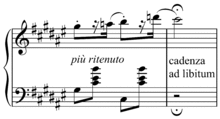Cadence (instrumental concert)
A musical improvisation by a soloist, usually at the end of the first movement of an instrumental concert, is referred to as a cadenza in an instrumental concert . The cadenza gives the soloist the opportunity to develop his virtuosity on the instrument. Usually the cadenza contains at least the main theme, and if there is a pronounced thematic dualism, the themes of the movement.
In the time of the Viennese Classic , the cadenza was usually introduced by the accompanying orchestra with an sixth-fourth chord and ended by the soloist with a trill leading back to the tonic on the leading tone above the dominant seventh chord , the sign for the conductor to let the orchestra begin the final turn.
Up until the time of Ludwig van Beethoven , the cadenza was often improvised. H. the soloist not only showed his skills on the instrument, but also presented himself as an improviser. As a result, the scores and piano editions of the concerts from this period do not have a specific cadence.
Some later soloists published the cadences they had developed in writing. These cadences can be purchased separately from the concert. So have z. B. Edwin Fischer and Fazıl Say wrote some cadenzas for Beethoven's piano concertos and Andor Foldes wrote some cadenzas for Mozart's piano concertos.
While Mozart wrote down cadenzas for very few of his piano concertos, Beethoven already composed at least one cadenza for all five piano concertos. For his 4th piano concerto he offers two cadences to choose from.
In the Romantic era , composers increasingly began to co-compose the cadences of their concerts. They are then notated in scores and piano editions and are accordingly played in the same way.
The composition of your own cadenza poses a special challenge with regard to the respective underlying work: The cadenza should respect the character of the work. For example, in a typical Viennese classical concert, a cadenza based on romantic music hardly seems appropriate. Ludwig van Beethoven himself showed that such rules are not always observed: for his 2nd Piano Concerto in B flat major op. 19 (which he composed before the first in C major op. 15 ) he wrote a "middle style" committed cadenza, which deliberately represents a stylistic break from the rest of the concert and precisely because of this builds up tension.
literature
- Daniel Gottlob Türk : From the ornamented cadences , in: Piano school, or instructions on how to play the piano for teachers and teachers . Leipzig and Halle 1789, pp. 308–322 ( digitized version )
- Friedrich Guthmann: About cadences , in: Allgemeine Musikische Zeitung , 7th year, No. 41, July 10th 1805, Col. 649–651 ( digitized version )
- Alexander Buhr: The solo cadenza in the piano concerto of the 19th century. Publishing house Dr. Köster, Berlin 2009, ISBN 978-3-89574-714-4 (Zugl .: Hamburg, Univ., Diss., 2009).
Web links
- Eva Badura-Skoda, William Drabkin: Cadenza. In: Grove Music Online (English; subscription required).
